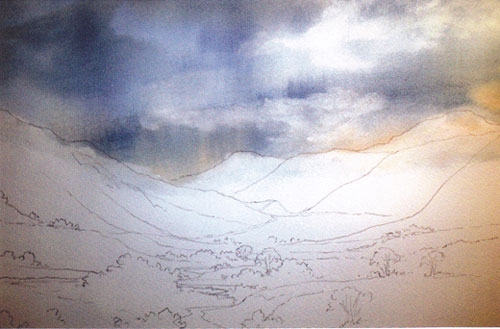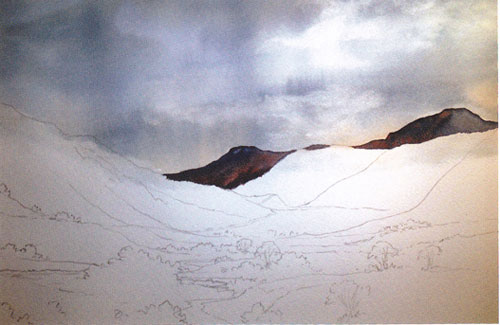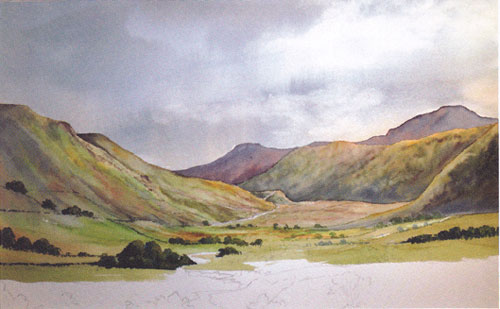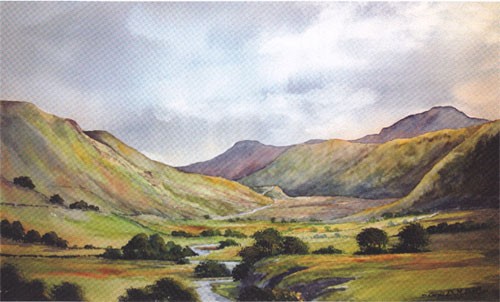Charles Evans Tutorial Using Winsor & Newton Watercolours
Charles Evans is an official Winsor & Newton demonstrator Artist. Read on for his superb tutorial using the six stunning colours in the Winsor & Newton Professional Watercolour range collectively known as the ‘Desert Colours’. Unfortunately, these colours have now come to the end of their limited run and are no longer available but there is still much to learn about applying watercolour from watching this beautiful painting coming together.
Painting the sky

In image 1, I’ve done a very basic outline drawing followed by my sky wash and for this I used my 1 ½ inch Cotman Wash Brush. Firstly pre-wet the whole sky area and then drop on a mix of the colours Gold Brown and Yellow Titanate just in to the bottom part of the sky then a mix of the Phthalo Sapphire with a tiny touch of Dark Brown and bring this from the top all the way down to the base of the sky and then darken the same mix with a touch more of each colour for the heavier cloud areas. Now I simply washed and squeezed out my brush and suck out a few clouds here and there. Importantly this is all finished whilst all is sopping wet.
Introducing strong colour

Once my sky was totally dry I used a mix of Phthalo Sapphire and Dark Brown, good and strong but be careful with this because these colours are so strong that you can practically make black with this mix, I don’t want it that dark. Again with my number 8 round brush I pre-wet all of these hills and popped a little of the Gold Brown into the top areas of the hills and then mixed Hookers Green with a little bit of Dark Brown and softly stroked the colours together, helping to merge and avoiding hard sharp lines. Now I popped a few touches of the Dark Brown in by itself, just a few hints here and there in the darker areas of the hill and then do the same with my Phthalo Sapphire and Dark Brown mixed. Soften the colours in with a clean damp brush and, importantly, finish whilst it’s still damp to avoid watermarks.
Creating a soft edge using colour and shade

In the next image it looks like I have done a heck of a lot between stages. That’s because I have, but it’s all really the same colour mixes and for this I used my ¾ inch flat Cotman Wash Brush. I firstly pre-wet the areas I was painting and then used a few strokes of Yellow Titanate here and there and Hookers Green mixed with Gold Brown, a few touches of Gold Brown by itself for the darker Yellow areas and then to add some real warmth, drop in a few hints of Transparent Orange. Importantly, again, work fairly quickly so all of these colours can be stroked together gently to give a softer edge between mountains and also giving a lovely warmth to the scene with the addition of the well watered Transparent Orange.
Adding impact to your watercolour, using colour

In the next image I started adding a few bushy bits, hedge lines and trees. I used my number 8 round brush for all of this and started off with the lighter sides which was a mix of Hookers Green and Gold Brown followed by, whilst still wet and to the darker sides, a mixture of Hookers Green and Dark Brown and finally, to add some real impact, a touch of Phthalo Sapphire to the darker sides and base of some of these brushes. It always sounds odd putting blue in to trees or grasses but if you are working whilst everything is still wet it doesn’t come out bright blue it just adds more depth to your green.
How to use bright colours in your painting

In the Penultimate image I painted in the river, which was purely Phthalo Sapphire with one heck of a lot of water in it, an extremely weak mix because, again remember, this is a very powerful colour. I finish off all the trees and for this foreground lot I used my ¾ inch flat Cotman Wash Brush and split it slightly and stipple on a few touches of fairly strong Yellow Titanate to get a little bit of light, followed by Hookers Green mixed with Gold Brown, then Hookers Green mixed with Dark Brown and finish them off with a little bit of Phthalo Sapphire mixed with Dark Brown for the extreme dark edges. I also used this same mix, practically black, for the darker sides of this tall riverbank. Add more water to the same mix and I just daubed in a few whole of the foreground and middle distance by carefully placing a few strokes of, firstly Transparent Orange, very well watered down, and a few of the tiniest little hints of Indian Red Deep, again very watered down. It is very clear to see where I have put these colours.
Painting in the final shadows

Now for the extremely scary bit, the adding of the shadows. Remember, all those hills on the right hand side are going to cast a bit of a shadow onto the landscape below, also some of the larger brushes and trees are going to cast a little bit of a shadow. Make sure the entire thing is dry and don’t prevaricate with your brush strokes. Use clear, strong and quick strokes so as not to disturb the underlying colours. You can see where I’ve put this shadow, especially the ones cast by the hills in the middle distance and foreground right hand side. I used my ¾ inch Cotman Wash Brush and a mix of Phthalo Sapphire and Indian Red Deep with plenty of water in it.
May 2014
